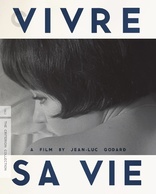Vivre sa vie Blu-ray Movie
HomeVivre sa vie Blu-ray Movie 
Vivre sa vie: Film en douze tableaux / My Life to LiveCriterion | 1962 | 84 min | Not rated | Apr 20, 2010
Movie rating
7.8 | / 10 |
Blu-ray rating
| Users | 4.4 | |
| Reviewer | 4.5 | |
| Overall | 4.5 |
Overview
Vivre sa vie (1962)
Nana, a young Parisian, aspires to be an actress but instead ends up a prostitute. Her downward spiral is depicted in a series of discrete tableaux of daydreams and dances.
Starring: Anna Karina, Sady Rebbot, André S. Labarthe, Guylaine Schlumberger, Gérard HoffmanDirector: Jean-Luc Godard
| Drama | Uncertain |
| Foreign | Uncertain |
Specifications
Video
Video codec: MPEG-4 AVC
Video resolution: 1080p
Aspect ratio: 1.34:1
Original aspect ratio: 1.37:1
Audio
French: LPCM Mono
Subtitles
English
Discs
50GB Blu-ray Disc
Single disc (1 BD)
Playback
Region A (locked)
Review
Rating summary
| Movie | 5.0 | |
| Video | 4.5 | |
| Audio | 4.5 | |
| Extras | 5.0 | |
| Overall | 4.5 |
Vivre sa vie Blu-ray Movie Review
Reviewed by Dr. Svet Atanasov March 29, 2010Jean-Luc Godard's "Vivre sa vie" a.k.a. "My Life to Live" (1962) arrives on Blu-ray courtesy of Criterion. The supplemental features on the disc include an audio commentary with film scholar Adrian Martin; an interview with French scholar Jean Narboni; an interview with actress Anna Karina first aired on the French television program Cinepanorama; "La prostitution", an episode of the French television series Faire face directed by Igor Barrere; Marcel Sacotte's study Ou en est: La prostitution; stills gallery; Godard's trailer for the film; and a 42-page illustrated booklet with essays and interviews. In French, with optional English subtitles. Region-A "locked".
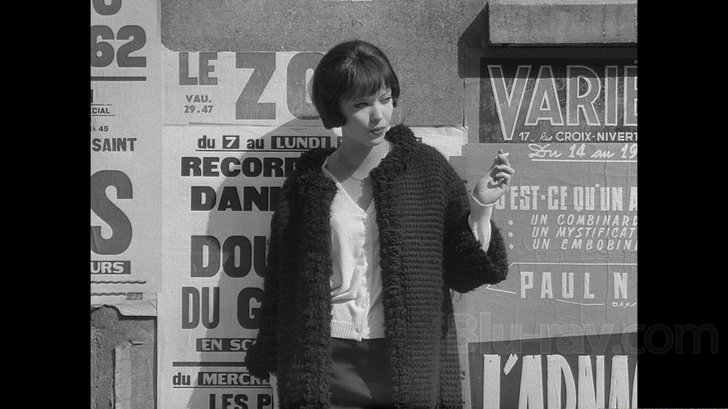
Lend yourself to others, but give yourself to yourself - Montaigne
In Jean-Luc Godard's Vivre sa vie a young Parisian girl, Nana (Anna Karina, Une femme est une femme), dreams of becoming an actress but instead ends up being a prostitute. She is naive and lonely. She likes flirting and almost always manages to have her clients pay her more than they had planned to. She also likes going to the cinema.
The film is divided into twelve "tableaux", each preceded by a short description explaining what the audience is about to see. One is an intellectual conversation about the meaning of life and love. Another describes in detail what a prostitute should and should not do if she wants to be successful. Another is a smart jab at classic gangster films. All of these "tableaux" are different but also very similar -- reflecting Godard's belief that life is cinema, and cinema is life.
Like the rest of the films Godard made at the time -- A bout de souffle, Une femme est une femme, and Le petit soldat -- Vivre sa vie questions the reality its protagonists belong to, as well as our perception of it. On the other hand, this is also a film that ultimately questions itself -- parts of it are about dreams and desires; other parts are about the subversive nature of beauty and its inability to survive in the real world in its most pure of forms. This is why Vivre sa vie is such a schematic film -- it constantly observes and thus questions everything it shows from the outside.
Perhaps the most unusual aspect of Vivre sa vie, however, is the framing. The opening scene shows Nana and Paul (Andre S. Labarthe), a man who she has apparently known for awhile, conversing in a bar. Nana is heading in one direction, Paul in another. There is no future for them and they explain precisely why. Godard, however, does not show their faces until much later into Vivre sa vie, offering a clue that not everything in the film would be revealed to the audience. It is better to understand first then see; not vice versa.
Raoul (Sady Rebbot, Tinto Brass' Chi lavora e perduto), the second man Nana encounters, also heads in a different direction. For awhile, it seems like he might provide her with the comfort and security she needs. Instead, Raoul explains to Nana how the prostitution business works, and then becomes her pimp. During the explanation part, Godard's camera observes the action from afar -- once again testing our perceptions and expectations about life and cinema.
Large parts of Vivre sa vie are notably monotonic, revealing Godard's then-current fascination with documentary realism. Iconic cinematographer Raoul Coutard's impressive lensing, however, brings a much needed balance in Vivre sa vie, truly transforming it into Godard’s most visually arresting film. Many of the key scenes in it, for example, resemble beautiful paintings.
The film's unique music score, courtesy of legendary French composer Michel Legrand (Les demoiselles de Rochefort), also has a very important role. A simple motif reappears during key scenes in Vivre sa vie, again, in a way, balancing Godard and Coutard's experimentation with sound (the entire film was shot in natural settings, and the actual soundtrack recorded directly on a single track).
In 1962, Vivre sa vie won the Special Jury Prize and Pasinetti Award (Jean-Luc Godard) at the Venice Film Festival.
Vivre sa vie Blu-ray Movie, Video Quality 
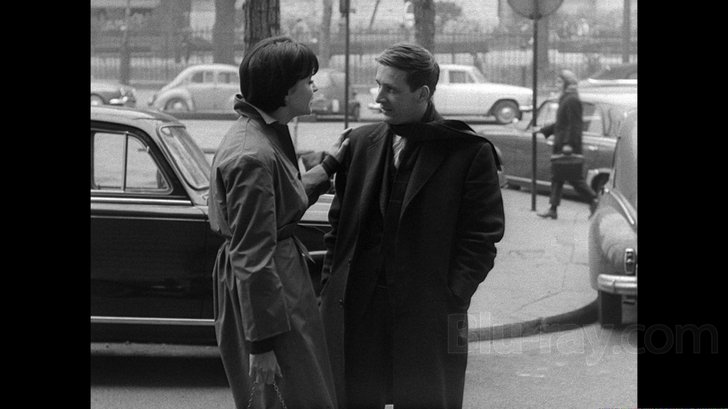
Presented in an aspect ratio of 1.34:1, encoded with MPEG-AVC and granted a 1080p transfer, Jean-Luc Godard's Vivre sa vie arrives on Blu-ray courtesy of Criterion.
Contrast and clarity are dramatically improved. For example, in Chapter 4, where Nana is questioned by the police, now we can clearly see her face - she looks sad, perhaps even frightened. On the UK DVD by Nouveaux Pictures, it is almost impossible to see Nana's face. The outdoor scenes also look notably better -- the film grain is a lot more prominent; the blacks and whites are richer and better saturated. The heavy digital noise that plagued the Nouveaux Pictures SDVD is also gone. Macroblocking is also not an issue of concern. Those of you with larger screens at home -- larger than 100' -- will be delighted with the depth and stability of this high-definition transfer. The famous dance scene, for example, looks absolutely fabulous. Finally, I did not detect any disturbing cuts, splices, debris, or stains to report in this review. (Note: This is a Region-A "locked" Blu-ray disc. Therefore, you must have a native Region-A or Region-Free PS3 or SA in order to access its content).
Telecine supervisors: Lee Kline and Maria Palazzola. Telecine colorists: Abdel Benlatreche/VDM, Paris; Gregg Garvin/Modern Videofilm, Los Angeles.
Vivre sa vie Blu-ray Movie, Audio Quality 
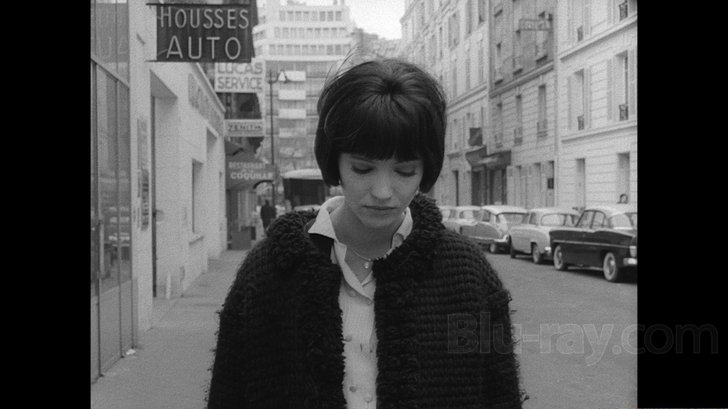
There is only one audio track on this Blu-ray disc: French LPCM 1.0 (Mono). Optional English subtitles are provided for the main feature.
The monaural soundtrack has been remastered at 24-bit from the optical prints. As a result, the dialog is clean, stable and easy to follow. Legendary French composer Michel Legrand's soundtrack also sounds lovely. There are no balance issues with it either. Finally, while watching Vivre sa vie, I did not detect any disturbing pops, cracks, or heavy background hiss to report in this review.
Vivre sa vie Blu-ray Movie, Special Features and Extras 
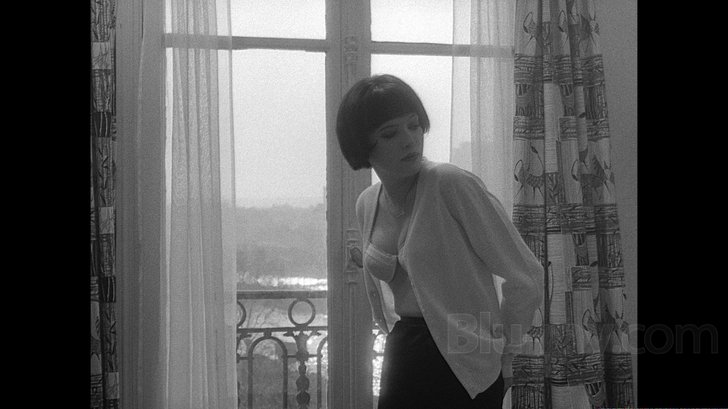
Commentary - an audio commentary with film scholar Adrian Martin recorded in 2001. Mr. Martin addresses the film's unconventional story and structure, Godard's unique filming technique, as well as the era during which the film was shot. Mr. Martin also draws excellent parallels between Vivre sa vie and some of Godard's more prominent films.
Jean Narboni on Vivre sa vie - an interview with French scholar Jean Narboni conducted in 2004 by novelist and film historian Noel Simsolo. Mr. Narboni's deconstruction of Vivre sa vie is exceptionally strong, explaining and pointing out a lot that the untrained eye would likely miss. Mr. Narboni also talks about Godard's evolution as a filmmaker. In French, with optional English subtitles. (46 min, 1080i).
Cinepanorama: Anna Karina - this interview with Anna Karina first aired on the French television program Cinepanorama on April 7, 1962, a few months before the release of Vivre sa vie. It was directed by Francois Chalais. Here, the Danish actress talks about her modeling career in Paris, as well as her encounter with Jean-Luc Godard. In French, with optional English subtitles. (12 min, 1080i).
Faire face: "La prostitution" - presented here are excerpts from "La prostitution", an episode of the French television series Faire face that first aired on February 24, 1961, and was directed by Igor Barrere. It features interviews with Max Fernet, Paris's director of police, and Marcel Sacotte, a magistrate and the author of the 1959 book Ou en est: La prostitution, from which Jean-Luc Godard took inspiration for Vivre sa vie. In French, with optional English subtitles. (22 min, 1080i).
Ou en est: La prostitution - Marcel Sacotte's 1959 study Ou en est: La prostitution served as inspiration for Vivre sa vie. Presented here are photos from Sacotte's expose, as well as a short piece by scholar James Williams on the connection between the film and the book. William's essay originally appeared in longer from in the collection Jean-Luc Godard: Documents, released in 2006 in conjunction with a Godard exhibit at the Centre Pmpidou. The essay is in text format, in English.
Stills gallery -
Godard's trailer - (3 min, 1080p).
Booklet - a 42-page illustrated booklet containing Jean-Luc Godard's Vivre sa vie scenario, first published in the Winter 1962 issue of Film Culture; film critic Michael Atkinson's essay "The Lost Girl"; "Godard on Vivre sa vie" - two interviews with the French director, one from the Winter 1962-63 issue of Sight & Sound, and another that originally appeared in Cahiers du Cinema; and Jean Collet's "An Audacious Experiment: The Soundtrack of Vivre sa vie", which first appeared in La revue du son in December 1962.
Vivre sa vie Blu-ray Movie, Overall Score and Recommendation 
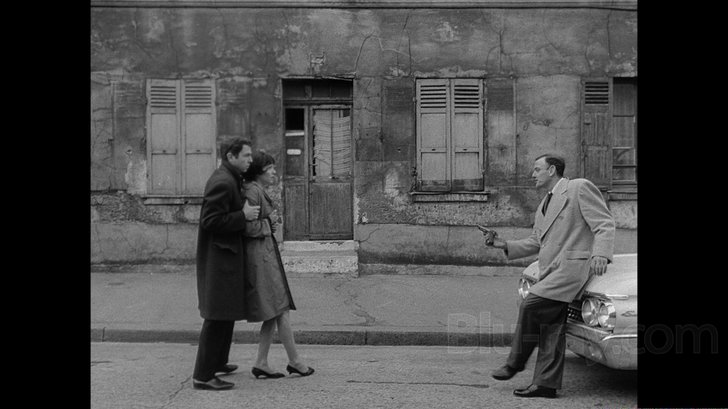
As expected, Jean-Luc Godard's Vivre sa vie looks absolutely stunning in high-definition. More importantly, Criterion's Blu-ray disc also features excellent supplemental features. I particularly enjoyed French scholar Jean Narboni's analysis of Godard's film. VERY HIGHLY RECOMMENDED.
Similar titles
Similar titles you might also like

Pierrot le fou
1965

Red Desert
Il deserto rosso
1964

Breathless
À bout de souffle
1960

The Last Metro
Le dernier métro
1980

Summer Hours
L'heure d'été
2008

The 400 Blows
Les quatre cents coups
1959

8½
Otto e mezzo / Federico Fellini's 8½
1963

Revanche
2008

Belle de jour
1967

The Traveler
مسافر | Remastered
1974

Last Year at Marienbad 4K
L'année dernière à Marienbad
1961

Army of Shadows
L'armée des ombres / Better encode than 2011 release
1969

Lola Montès
1955

The Seventh Seal 4K
Det sjunde inseglet
1957

Chungking Express 4K
重慶森林 / Chung Hing sam lam
1994

The Conformist
Il Conformista | 4K Restoration
1970

Band of Outsiders
Bande à part
1964

Everlasting Moments
Maria Larssons eviga ögonblick
2008

L' Atalante
1934

Bigger Than Life
1956
